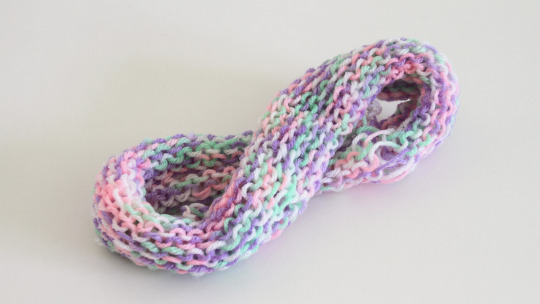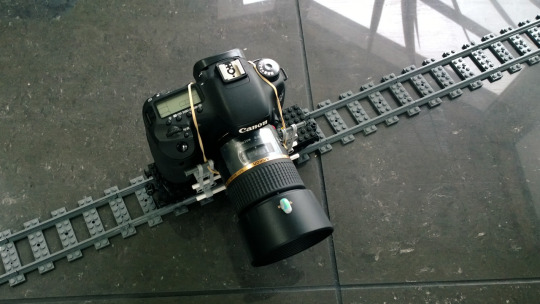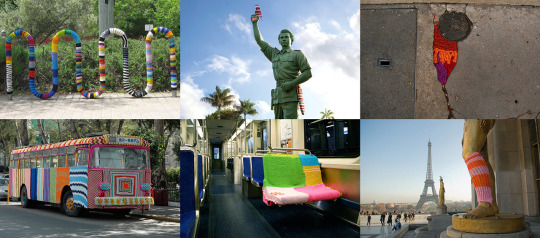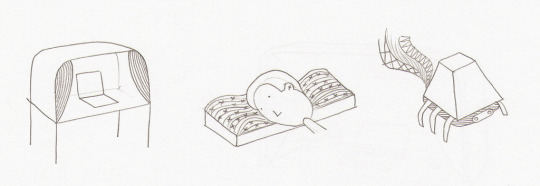Link
0 notes
Video
vimeo
The Knitted Office is a circular knitting machine that has been augmented with an electrical motor. The machine is placed in one’s office, switched on and the knitted material harvested. While there are no limits as to how the knitted material is used, some possibilities include: decoration, creating a parasol to shield from the sun, closing up a draft, softening a slamming door, or muffling one’s surroundings (including noisy co-workers).
0 notes
Photo


Samples of knitted material that took approximately five minutes for the machine to produce.
0 notes
Text
Rationale
Comfort in its contemporary usage can be typified as “that condition of mind which expresses satisfaction with the environment” (Shove, 2004). The evocation of comfort is often ascribed explicit material attributes such as softness, fluffiness, cushioning, snugness and warmth (Baker, 2013a; Shove, 2004). These attributes could all be considered natural extensions of the term’s original reference to the provision of physical or mental strength (Baker, 2013b). Beyond such material qualities, comfort is also associated with one’s home environment (e.g., by providing a sanctuary from the world), and as a mechanism to cope with change or the unfamiliar (Baker, 2013b). Shove’s position that comfort relates to control over one’s environment (2004), and the material qualities of wool indicated an opportunity to evoke comfort in the contemporary office environment by making it feel a little less like work, and a little more like home.
The Knitted Office (hereafter TKO) is a circular knitting machine that has been augmented with an electrical motor. The machine is placed in one’s office, switched on and the knitted material harvested. To encompass a broad perspective on comfort, there is intentionally no direction as to how the harvested material is to be used.
Raymond Williams used the phrase “a structure of feeling” to describe “the continuity of experience from a particular work, to its recognition as a general form, and then the relation of this general form to a period” (Williams, 1969). The term attempts to dissolve the notion of a ‘standard of perfection’ (to which culture should aspire), by acknowledging all culture as valid and distinctly ordinary (Baker, 2013a). I interpret this to refer to the sociocultural characteristics of a given period or environment (which may be subconscious, tacit or not easily explicated). Nevertheless, the term is useful in highlighting the value of context in emotional analysis.
TKO attempts to build on specific social phenomena that have used making processes to “creatively [and non-destructively] modify cultural and physical landscapes” (Vachhani, 2013, p.91). Yarn bombing is one such precedent; it can be considered to be a form of outdoor urban art, that aside from the medium used (knitted wool) and its semi-permanence, is broadly similar to spray-painted graffiti (being customarily illegal and often conducted by stealth). Notwithstanding its later tangential use as sociopolitical commentary (Vachhani, 2013), yarn bombing originated as a method to beautify ‘sterile’ urban environments (for example, by knitting around lampposts and park benches).
“When the expected, the routine, and the standard takes hold in the work, home… it clamps down on our aspirations”
-– (Gobé, 2009, p.2)
Employing a similar ideology to yarn bombing are Throwies; small, self-contained, deployable LED light sources that use magnets to affix to metallic surfaces (Seitinger, Perry & Mitchell, 2009). Throwies would appear to provide more immediacy than yarn bombing, albeit with a less involved making process. Nevertheless, parallels can be drawn from both activities with Shove’s conception of comfort as having control over one’s environment (2004). Beyond the personal empowerment that comes with designing ‘from the soul’ and manifesting in a tangible output, a creative making process can act as an enabler and lubricant “between social networks or communities and between the physical and aesthetic experience of space” (Vachhani, 2013, p.96).
While ideologically different to both yarn bombing and Throwies, the act of knitting in wartime further substantiates the cultural modification that can result from the making and sharing process (Gschwandtner, 2008). In particular, the potency of yarn bombing that results from its medium and refreshing context suggest a powerful role for experiences such as that provided by TKO to transform contemporary office spaces and make them more comfortable (Vachhani, 2013).
“[T]he worker therefore only feels himself outside his work, and in his work feels outside himself. He is at home when he is not working, and when he is working he is not at home.”
– Karl Marx (1974, as cited in Gregg, 2011, p.39)
In the time since Marx’s proposition, online technology has been instrumental in enabling flexible workplaces, thus blurring distinctions between work and home-based activities (Duffy, 2008). Gregg (2011) cites problems with the reality of working from home that include the compulsive checking of email and workplace activities; along with domestic stress caused by the blurring of workplace and home life. Critically, Gregg argues that employers inadequately address and resource working from home (2011). TKO attempts to alleviate the issues of home life becoming more like work, by attempting to make work more like home. Beyond promoting fun and whimsy, the experience it offers aims to foster both the self-identity and control (integral to the practice of both knitting and yarn bombing; Gschwandtner, 2008) that Gregg asserts is lacking within the workplace. Essential to the success of the experience is the materiality and emotions associated with wool.
“[A] fascination with the tactility of yarn, the ridges, the weave, the feeling of wool on one’s skin still haunt me… yarn is both rough and smooth; soft and hard to the touch; it is symbolic of warmth, passion, joy”
– Vachhani (2013, p.96)
The experiences and memories associated with the sensory feedback provided by wool (e.g., of grandparents; of a mother’s embrace; of childhood/nostalgia) indicate the significance of context to generate powerful emotional reactions (Baker, 2013c). As with yarn bombing, the critical element of TKO to generate a profound response is the transfer of familiar emotional linkages (between visceral, behavioural and reflective responses; Norman, 2004) to a new context (Vachhani, 2013).
The Knitted Office offers a critical perspective on the inexorable invasion of the workplace upon home life. Building upon the transformative ideologies of making cultures such as yarn bombing, the experience denotes a fun and whimsical atmosphere within the workplace. Further, the strong emotional responses afforded by the materiality of wool and the refreshing context within which knitting is placed promotes identity, control and ultimately comfort for office workers. While there are no limits as to how the knitted material is used, some possibilities include: decoration, creating a parasol to shield from the sun, closing up a draft, softening a slamming door, or muffling one’s surroundings (including noisy co-workers).
0 notes
Text
Further research
Make the knitting machine more accessible. The one I used was bloody hard to source and very expensive. I am currently reverse-engineering the design and think it would be possible to create a laser cut version, plans for which could be distributed freely online.
Although my intention for this project was to focus on the making process (and the resulting experience; hence the crude Lego additions) rather than the design of the actual object, I think it could definitely be made smaller and more pleasing to the eye.
Sensors and stuff could be added. I think it'd be really interesting to have the machine controlled by environmental factors; like perhaps the energy of doors shutting in the office, or even sunlight.
0 notes
Video
vimeo
Quick video of the making process, with silly music to show this is more for completeness than grading.
0 notes
Photo

The knitting machine is amazing. This is took about five minutes.
0 notes
Photo

Tracking test. Way too wobbly, I'll need to look at using a pair of tracks.
0 notes
Quote
I still would love to get that clock that knits as it tells time.
Rock and knit - Fiber Arts
0 notes
Photo

I considered vacuuming as evoking comfort through the transformation of one's environment. I think there is a lot of potential to continue this for the third project, but I really want to produce something that is represents my design 'philosophy' (as pretentious as this sounds), rather than pandering to the brief, which is what I think my current ideas do (these progressively tend towards speculative critical designs, which I'm trying to avoid):
Making the vacuum cleaner silent;
Using the kinetic energy expended while vacuuming to produce something (comforting) like a sock, or to power a fragrant humidifier;
Anthropomorphically modifying the vacuum cleaner (e.g., by making its surface squishy, translucent and reactive to unexpected stimuli (e.g., when it bumps into the jutting corner of a room);
Packaging the vacuum cleaner together with a human assistant in the box.
So, my revised idea works on a similar concept to vacuuming to evoke comfort, except with more tangibility, practicality and meaning. The idea is to evoke comfort by transferring the phenomenon of yarn bombing to the office environment. I've worked in a open plan office before, and it was overwhelmingly sterile, artificial and impersonal (pretty much like this one). I feel that if there was a simple way to transform and personalise one's personal space within the office to make it more comfortable, covering it in warm and fuzzy wool would be it. In addition to being indoors, the other major difference between my proposition and yarn bombing would be the provision of a machine to the subject, that would do the knitting for you (I'm currently working on prototypes of this).
0 notes
Photo

Some ideas:
A cover for your table that gives you a private, personal space to do your work;
A kit to grow your own bed of moss;
A cute little wooden bug that spins a yarn. Maybe replace the bug with an existing object found in the office that moves (like a fan, a door, or chair casters).
0 notes
Video
vimeo
For this experiment I had something baking in the oven while participants vacuumed, with the intention of producing a distinctive and noticeable smell. While the olfactory warmth and softness of baking were comforting, it was fleeting and almost hollow, since the proximity of the sensory alteration was too distant to evoke meaningful comfort – participants still had to undertake vacuuming, which was generally considered a chore (albeit with the psychological motivation and reward of being able to consume cake upon finishing vacuuming). For my subsequent experiments, I wanted to make the connection between the alteration and the activity more direct.
0 notes
Video
vimeo
The inspiration from this experiment came from my own experience of having to bend down while vacuuming, even with the vacuum cleaner’s wand extended to its longest position. To analyse the extent to which this ergonomic adjustment could elicit comfort, I asked my sister (who is shorter than me, and can thus access a comfortable wand length) to use the vacuum cleaner with the wand retracted such that her back was forcibly arched. She then repeated the activity with the wand extended to a comfortable length. In addition to relieving physical discomfort and improving vacuuming efficiency, a ‘comfortable wand’ changed my sister’s visual sensory input, so that she was able to spend less time facing the ground, which connotes generally negative emotions if not explicit discomfort. While at its core this experiment focused on simple issues of ergonomics, I found it interesting to note the lack of accommodation provided to (relatively) tall users of vacuum cleaners. I couldn’t find an apt explanation for this, but my sister came to the rescue:
“Vacuuming is probably designed for girls since it’s our job and we’re shorter” – Jaini
0 notes

